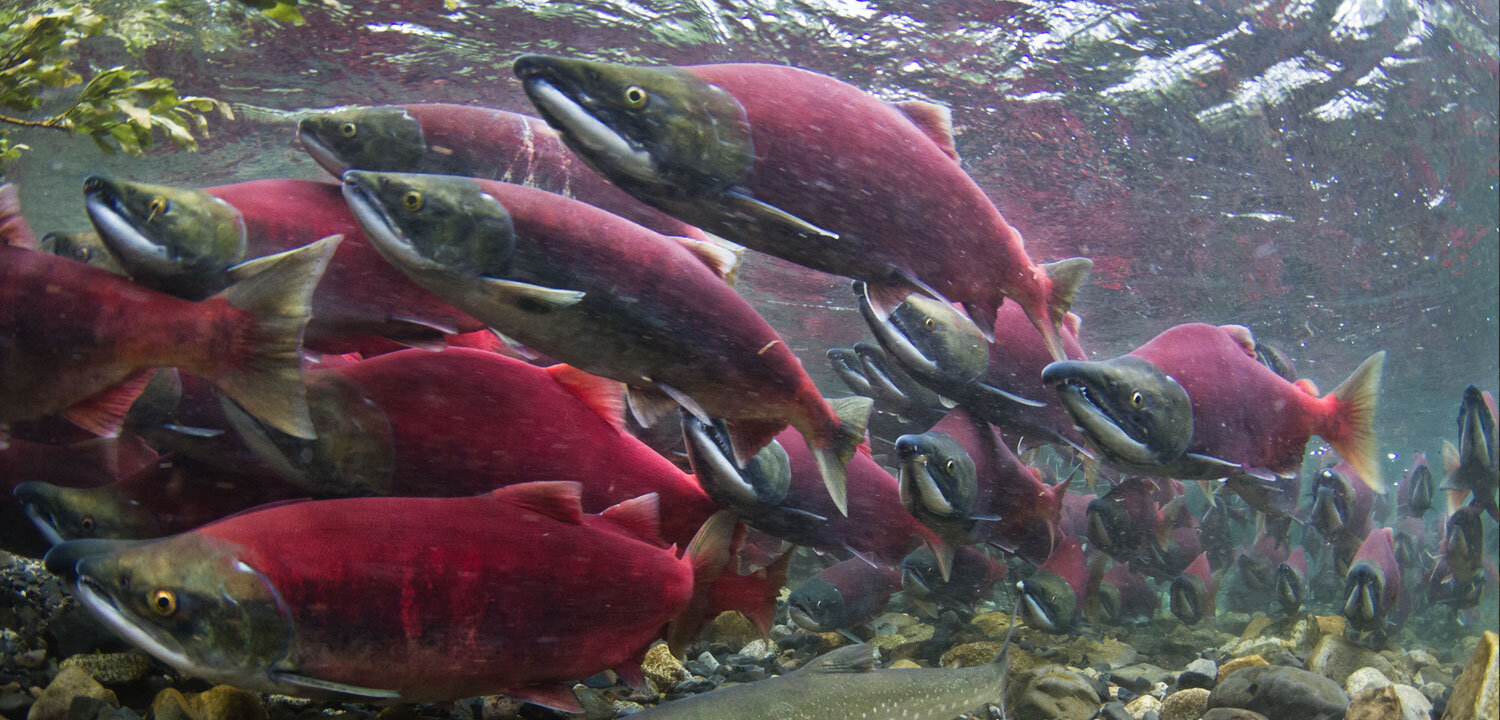
Salmon & Steelhead
We’re working to recover Idaho’s most iconic, wild fish.
Idaho was once home to one of the most abundant salmon runs in the world. They are now critically endangered in the Snake River Basin. Idaho’s salmon population began to plummet in the 1970s following the construction of the Lower Snake River Dams.
Since the 1950s, Idaho’s salmon and steelhead runs have declined by more than 80%. Once constructed, Idaho’s salmon encountered eight dams during their migration to and from the ocean. While the four dams on the main stem Columbia River, constructed in the 1920s & 1930s, reduced Idaho’s salmon population, it was the addition of the Lower Snake River Dams (1962-1975) that pushed Idaho’s salmon to the tipping point of unsustainable numbers.
Decades of science and data trends have shown that restoring the Lower Snake River through dam removal is the single most effective strategy for salmon and steelhead recovery. The four dams are outdated and costly, and the minimal services they provide can be replaced by other means. It is time for a regional solution and swift action to restore the Lower Snake River and Idaho’s salmon.
ANADROMOUS FISH LIFE CYCLE & MIGRATION PATTERNS
Pacific salmon and steelhead are anadromous fish, meaning adults migrate from the ocean to spawn in freshwater lakes and streams where their offspring hatch and rear prior to migrating back to the ocean to forage until maturity. The migration and spawning times vary considerably between and within species and populations (Groot and Margolis, 1991).
Life Cycle:
At spawning, adults pair up to lay and fertilize thousands of eggs in freshwater gravel nests or “redds” excavated by females. Depending on lake or stream temperatures, eggs incubate for several weeks to months before hatching as “alevins” (a larval life stage dependent on food stored in a yolk sac). Following yolk sac absorption, alevins emerge from the gravel as young juveniles called “fry” and begin actively feeding. Depending on the species and location, juveniles may spend from a few hours to a few years in freshwater areas before migrating to the ocean. The physiological and behavioral changes required for the transition to salt water result in a distinct “smolt” stage in most species. On their journey, juveniles must migrate downstream through every riverine and estuarine corridor between their natal lake or stream and the ocean.
Migration Patterns:
These fish are amazing for many reasons, one being their residency and determination to survive. They change their bodies inside and out (internal organs have to transform to salt water and back to fresh water for instance), and adapt, while migrating for months on end. For example, smolts from Idaho will travel as far as 900 miles from their inland spawning grounds *(the Middle Fork of the Salmon River) En route to the ocean, the juveniles may spend from a few days to several weeks in the estuary, depending on the species. The highly productive estuarine environment is an important feeding and acclimation area for juveniles preparing to enter marine waters.
Different species of fish migrate and "home" for different time periods, and mature and various ages. For example, pink salmon mature at 2 and coho at age various ages, and are not always the same. Juveniles and subadults typically spend from 1 to 5 years foraging over thousands of miles in the North Pacific Ocean before returning to spawn. Some species, such as coho salmon, have precocious life history types (primarily male fish) that mature and spawn after only several months in the ocean. Spawning migrations known as “runs” occur throughout the year, varying by species and location. Most adult fish return or “home” with great fidelity to spawn in their natal stream, although some do stray to non-natal streams. Salmon species die after spawning, while steelhead may return to the ocean and make repeat spawning migrations.
This complex life cycle gives rise to complex habitat needs, particularly during the freshwater phase (Spence et al. 1996). Spawning gravels must be a certain size and free of sediment to allow successful incubation of the eggs. Eggs also require cool, clean, and well-oxygenated waters for proper development. Juveniles need abundant food sources, including insects, crustaceans, and other small fish. They need places to hide from predators (mostly birds and bigger fish), such as under logs, root wads, and boulders in the stream, as well as beneath overhanging vegetation. They also need places to seek refuge from periodic high flows (side channels and off-channel areas) and from warm summer water temperatures (coldwater springs and deep pools). Returning adults generally do not feed in fresh water but instead rely on limited energy stores to migrate, mature, and spawn. Like juveniles, they also require cool water and places to rest and hide from predators. During all life stages, salmon and steelhead require cool water that is free of contaminants. They also need migratory corridors with adequate passage conditions (timing, water quality, and water quantity) to allow access to the various habitats required to complete their life cycle."
Salmon Story Maps & More Resources
Idaho & Salmon: Our history, culture, and connection
The issue of the Lower Snake River Dams
How we got here: The story of Idaho’s salmon decline
Idaho: A Critical Home for Chinook Salmon and Bull Trout
Chinook Salmon and Bull Trout are native indicator species throughout the rivers of the Pacific Northwest. Human development and industrialization have caused great declines in salmonids, to the point of both species becoming ESA-listed.
Idaho is known to host pristine habitat for these fish. However, there are some major barriers to accessing these natural sanctuaries for both the Chinook Salmon and Bull Trout species. Dams, mining, and other extracting projects decrease the access to habitat for Chinook Salmon and Bull Trout. Along with physical obstacles, these projects influence water temperatures and water quality, making a once perfect habitat for fish now an undesirable river for these species.
Lower Snake River Restoration Map coming soon!
News on Salmon & Steelhead









